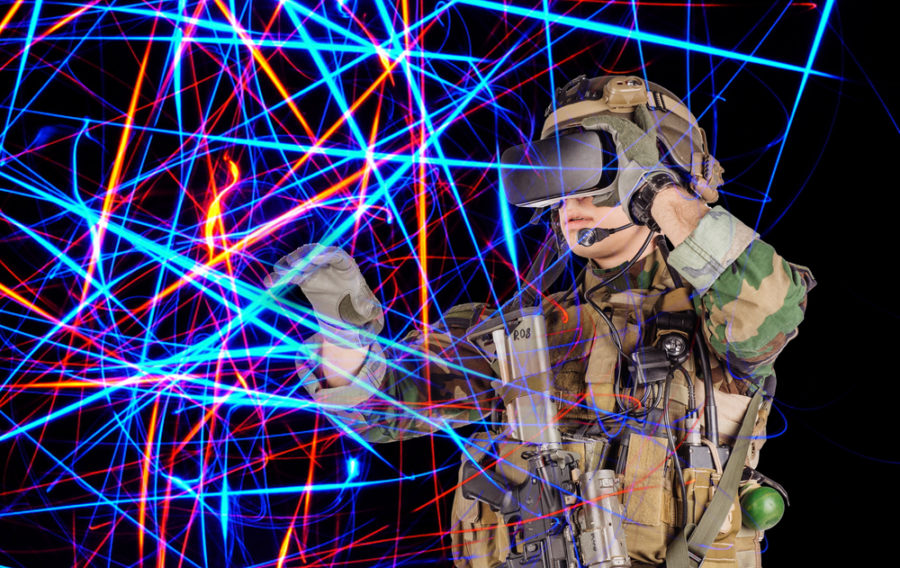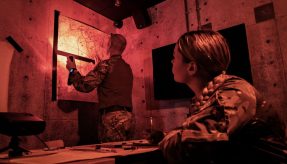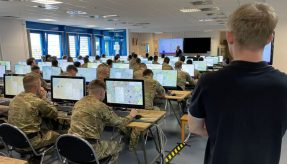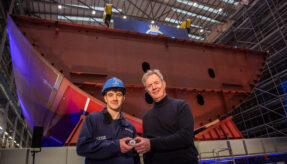
Maintaining sophisticated military equipment across land, sea and air is a difficult enough challenge when the required resources are readily available. So how can the military balance equipment availability with a reactive and compliant maintenance strategy and supply chain when the number of skilled engineers is limited? Here, Graham Grose, Vice President and Industry Director at the Aviation & Defence Business Unit at IFS, examines the use of augmented reality to deliver maintenance expertise from anywhere in the world.
The market for virtual and augmented reality is growing – one report from Digi-Capital predicts the VR/AR market to be worth $120bn by 2020. Virtual reality has hit the consumer world with a bang, and the defence sector is now starting to see the power of the technology, and its close ‘relation’ augmented reality, in action. The UK MOD recently explored the potential of augmented reality for in-field geospatial and context-awareness in its Joint Focus Experimentation 3 project. One application gave troops inside a windowless vehicle a complete 360-degree view of outside terrain.
Training for maintenance a real opportunity
The technologies have been used to simulate training exercises to speed up and reduce the costs associated with readying military personnel for deployment. But only now are we seeing them implemented to fulfil a growing requirement for defence organisations – the global issue of effectively and flexibly deploying scarce and expensive maintenance personnel.

Growing asset complexity requires skilled engineers
Military assets continue to grow in complexity. Forces across the globe are beginning to take delivery of the F-35 Joint Strike Fighter, the most complex and capable military jet ever manufactured. Larger assets such as the Nimitz-class super aircraft carriers also pose significant maintenance challenges. It’s estimated the USS Theodore Roosevelt contains over 1,000 miles of electrical cable and an air conditioning plant capable of sustaining 500 houses. It’s no surprise that it took some four years to complete the mid-life refuelling and complex overhaul (RCOH) of the carrier from 2009 to 2013.
Increasing asset complexity, the decline in defence personnel numbers and a maintenance training lag means having the right engineers in place to keep equipment available is becoming a difficult management task.
Supply loses out to demand from booming commercial aviation market
On one hand, the sophisticated equipment entering defence supply chains requires significantly longer lead times on training. Maintenance personnel are trained – and qualified – to perform specific repairs on specific equipment and, particularly on aerospace assets, nothing else. On the other hand, the military cannot compete with the booming commercial aviation industry, especially in the fast-growing Middle East and Asia-pacific where airline operators and MROs can headhunt military personnel with attractive salary offers, work hours and safer environments.
The demand for maintenance is rapidly outpacing supply. In a 2014 report, the UK Military Aviation Authority (MAA) reported that the RAF was missing 411 tradesmen for aircraft maintenance – a 12% shortfall in the number of trained engineers the MOD required. New, innovative solutions are needed to help bridge this gap.
Globalisation provides a huge logistics footprint
Add to this the fact that military engagements are less-predictable now than ever before. Insurgency-based threats can arise anywhere at any time, and counter-terror warfare requires defence organisations to be prepared to respond as quickly as possible. Sending a fully effective defence force forward requires maintenance expertise to be available close to the area of operation. Maintenance personnel then need transport, food and shelter, not to mention force protection – quickly becoming the start of an ever-growing logistics footprint.
It’s worth remembering that in the Crimean war there were no logisticians involved. Major developments since then means that across all three services in the UK, 1 in 6 personnel are now directly involved in logistics. In a modern air force organisation, such as the USAF and RAF, 95% of trades are non-pilot supporting roles.
Three options, one clear winner
When positioning maintenance personnel to maximise force readiness, defence organisations are faced with three options:
- Strategically position maintenance engineers geographically
One option for defence forces is to deploy units and maintenance personnel in likely areas of conflict. With insurgency-type threats arising without notice in any given area, second-guessing these potential conflicts would require deployment of many maintenance troops and engineering equipment, not to mention life support in different locations. However, even deploying a small force involves a spiraling logistics footprint – and cost – involving equipment, fuel, food, ammunition, security, spare parts and more – plus the transport infrastructure to rotate them. A small deployment soon becomes a long-term camp – witness the UK MOD Camp Bastion in Afghanistan which is estimated to have cost £1bn over its lifespan, supporting 28,000 troops, 4,032 contractors and 3,080 vehicles. - Operate a ‘fix when required’ approach
Should defence forces risk leaving a vehicle, weapon or plane sitting idle in a remote location and fly a qualified engineer out to fix it on an as-required basis? With forces spread in remote locations, flying a skilled engineer out to the front line to repair stricken equipment can take time – time which defence forces simply cannot afford. In many cases, it may be too dangerous to deploy a maintenance engineer in the field, leaving squads cut off without mission-critical equipment. In addition, until a maintenance assessment has been completed at the asset, it’s not always obvious which engineer role, qualification and equipment is needed to affect the repair. - The third way – augmented and virtual reality
Using remote guidance via a wearable or mobile device, engineer skills can be ‘augmented’ as more qualified technicians provide expertise from any location in the world. Virtual reality simulation can even speed the training process itself. At the 2016 MRO Europe conference in Amsterdam, ICF International vice-president Jonathan Berger predicted virtual reality could shave one or two years off traditional maintenance engineer training programs. AR and VR could be of particular interest to the military in the coming years as the technology continues to mature. A one-to-many delivery of expertise from a central hub to remotely deployed engineers has the potential to drastically reduce training times, improve maintenance efficiency and bring huge cost savings.
Augmented reality provides a ‘win-win’ solution
Current mobile solutions support collaboration and drive better data capture and compliance, but even these devices cannot solve the ‘right skills in the right place’ issue. Maintenance personnel could of course contact senior technicians via mobile, but there is no way of seeing or demonstrating how a task should be executed. These are often operational or airworthiness decisions after all. Integrating the latest technology with a configuration-controlled solution adds the necessary rigour to remote maintenance tasks.
Augmented reality specialist XMReality has been working on remote guidance in the field, enabling junior engineers involved in a repair to instantly contact experts back at base. The company has designed an augmented reality solution for the Swedish Defence Materiel Administration (FMV) because of the increased efficiency the technology offered organisations in other industries.
Using remote guidance, a support technician can see the asset in real-time and guide the engineer through every step of the repair with augmented hands and tools – all without having to leave base. Using smartglasses, mobile devices or tablets, engineers can see a real-time and interactive demonstration of the repair job right in front of their eyes. These skills can be leveraged anywhere, any time with the capability of modern mobile technology, helping improve first-time fix rates and decrease the chance of error.
What’s next – keeping soldiers safe and missions on-course
When these AR and VR technologies are integrated with a supporting enterprise asset management or MRO solution, the maintenance operator can quickly report and complete repair jobs – getting mission-critical equipment back up and running as soon as possible.
The next step will be to develop these solutions to the point where they can be feasibly used on the frontline or in the bowels of an aircraft carrier, without compromising repair time, soldier safety and mission success. Functionality must be tailored for ease of use in the field, keeping in mind the conditions a soldier or front-line engineer may be operating in – possibly kitted up in chemical, biological, radioactive and nuclear equipment or in the dark bilge of an at-sea submarine.
With augmented reality maximising engineer efficiency, defence forces will no longer have to mind the gap when it comes to maintenance resource shortage.
If you would like to join our community and read more articles like this then please click here








